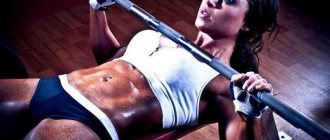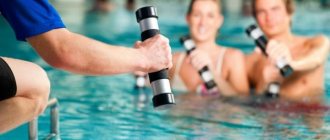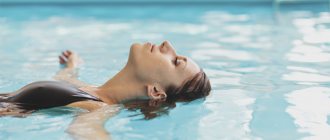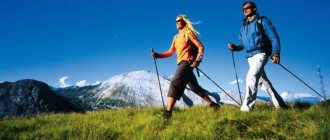Protection and safety while sailing ( 2 votes, average: 5.00 out of 5)
Women's swimming is an active sport, which today is used not only as an interesting and entertaining hobby, but also to get your body in order, keep your muscles toned, and even get rid of excess weight. In addition, the benefits of swimming have been repeatedly proven for those who have problems with the vestibular system and spine, as well as suffer from scoliosis and osteochondrosis.
How to choose a swimsuit, suit, shorts for women's swimming
Even for those who engage in this sport purely out of curiosity and personal reasons, it is very important to do it correctly and professionally. It is important to say that the right approach can provide good results and excellent performance. However, a love of water procedures and an experienced trainer are not all you need to provide yourself with in this procedure.
The rabbit is the fastest species
The crawl on the chest looks like this:
Movement algorithm:
- The hands take turns making strokes: the hand hooks the water and makes a stroke towards the body, reaches the hip, then sweeps over the top and goes back into the water.
- The legs also take turns performing swings.
- Head in the water. Exhale into the water through the nose and, if necessary, through the mouth; to inhale during the stroke, the body and head are turned to the side to inhale through the mouth, as shown in this photo:
If you want to learn more about the rabbit, go to the section of the site using this link. It talks in detail about technique, exercises and how to learn this method of swimming.
We also note that the crawl is the fastest of all styles (the proof is in this article). For this reason, it also has another name - “free style” : in freestyle competitions, swimmers can choose any method, but in modern times they only choose crawl in such races.
However, the difference in speed is not important for amateur swimming, since in this case we are talking about seconds.
Basic principles of warm-up
Warm-up is a strictly individual process. Exercises for swimmers may differ in complexity and duration. But still, there are several leading principles of proper warm-up, the observance of which is mandatory for every athlete:
- Punctuality – you must arrive on time for training in the pool or for a competition. Being late not only reduces preparation time, but also causes stress, which can lead to decreased productivity and errors.
- Sequence - first you need to perform the exercises on land, moving from the top to the bottom, and then start swimming in the water.
- Develop tactics - analyze the details of your technique, focus on your strengths, focusing on breathing, hip position or the optimal number of strokes. At the same time, it is necessary to note which elements are performed naturally and which require additional effort.
- Emotional and physical relaxation will allow you to concentrate on pace rather than power, thus achieving high speed without extra effort.
- Increased heart rate and depth of breathing.
The duration of a standard warm-up is about 15-20 minutes. But in case of lack of time, its duration can be reduced to 5 minutes by completing the basic elements of the complex. Children warm up much faster than older ones due to natural flexibility, which we lose with age.
Breaststroke is the most energy efficient way
Breaststroke looks like this from the outside:
Movement algorithm:
- The arms simultaneously make a stroke - they are pulled towards themselves, then thrown forward again.
- At the moment of pulling up the arms (and thanks to it), the head and shoulders rise above the water to inhale . Then the face is lowered into the water to exhale.
- As the stroke progresses, the knees are pulled up, then at the moment the arms are thrown out, the feet and legs are spread apart (the knees are not spread) and a push is made with the legs . At the end point of the push, the feet are brought together (the meaning of the movements of the stupas is that they seem to push off from the water, making a stroke).
A more detailed description of breaststroke and its technique is given in detail in this section of the site.
Breaststroke is considered the most energy-efficient way of swimming, that is, requiring less energy . If you are tired, then by swimming this way, you can glide for a long time after each stroke, saving energy.
On the other hand, many people call breaststroke the hardest style to master.
It is believed that learning the correct breaststroke technique is more difficult than freestyle:
Photo - moment of kicking in breaststroke
- it is very important that the pulling of the legs and the push are done at the right moment; precise synchronization of the actions of the whole body is required;
- the correct leg technique is difficult to master (as opposed to simple crawl swings);
- It is important not only to make the stroke correctly with both hands, but also to throw them forward correctly - so that there is advancement and sliding, and not braking of the body.
To learn how to swim breaststroke, read this link.
Warm-up on land for swimmers
The main goal that warming up on land before swimming allows you to achieve is to warm up the body before directly immersing yourself in the water. You should always start from the upper body, gradually working your way up to your feet. On land, all exercises should be performed slowly and smoothly. You need to start with simpler swings, gradually moving on to more complex rotational exercises, increasing the intensity and amplitude.
You should move on to working the next section only if the previous muscle group has been fully warmed up. Evidence of this is an increase in their elasticity and mobility. A properly warmed muscle allows you to do things that were difficult or brought significant discomfort at the beginning of the workout.
Basic dry warm-up exercises:
- Walking turns into running. Jumping on your toes on the side. Duration - about two minutes. Helps warm up the body, preparing it for further stress.
- Working out the neck - turning your head in different directions. This way the cervical vertebrae fall into place.
- Wrists - scrolling the hands in one direction and then in the opposite direction.
- Arms – rotation of the arms at the elbow joints.
- Shoulders - swing your arms forward and back. Allows you to relieve stiffness and tension.
- Back – increasing flexibility through lateral bending and rotation.
- Hip department – rotation of the pelvis.
- Legs – knee rotation, squatting.
- Ankle area - rotation of the leg in the ankle joint area, resting the toe on the floor or holding it in the air.
To finish, you can perform stretching exercises, both static and dynamic.
Important! Increased flexibility helps lengthen muscle fibers, which increases endurance and strength.
Butterfly technique - photo and description
Butterfly (aka “dolphin”) is rightfully considered the most spectacular style:
Movement algorithm:
- The main feature of the technique is the wave-like movements made by the body.
- The arms simultaneously make a stroke , but, unlike the breaststroke, they are not immediately thrown back, but go to the thigh, then thrown back over the top. Hand movements are synchronous with the wave-like movements of the body.
- The legs work as a single “tail” , striking synchronously with the wave moving through the body.
- To inhale, the head and shoulders are raised during the stroke , then the face is lowered into the water to exhale.
Read more about what butterfly stroke is and how to swim it correctly on this page.
The butterfly swimmer looks very beautiful and effective - see for yourself:
However, the downside of this beauty is the large expenditure of energy: this is the most exhausting method of swimming, requiring both good endurance and strong muscles of the back, lower back, abs, and shoulders.
It is definitely not suitable for beginners - it is usually mastered after crawl and breaststroke.
Warm up in the water
You can proceed to water warm-up only after performing quality exercises on land. The water complex allows the swimmer to adapt to the temperature of the pool and develop a strategy for the upcoming workout based on his well-being and condition.
There is no single standard for warming up, but there are still a number of exercises that are recommended. In water, the basic complex may consist of:
- Peaceful sailing. Natural and free, but technically correct movements of the arms, legs, body and head.
- Exercises - using only the arms or legs, with an extremely reduced number of strokes performed.
- Special exercises aimed at improving coordination and swimming technique.
- Working on breathing - holding your breath during diving and swimming, swimming distances with a controlled number of breaths.
- Swim sections at medium speed.
- Swimming at 80% maximum speed.
- Swim the segment at the speed limit.
- Restorative swimming – stabilization of heartbeat and breathing.
The amount of distance swam directly depends on the athlete’s level of training. The average distance varies from 200 to 800 m or more. The swimmer's warm-up, the set of exercises and intensity, may also depend on the level of excitation of the athlete's nervous system.
In a depressed state, it is better to increase the speed and power load to activate the nervous system and produce a sufficient amount of adrenaline. If there is excessive excitability, on the contrary, you should give preference to moderate movements and voluntary bathing.
On the back
Backstroke swimming usually means backstroke (although backstroke also happens):
In general the algorithm of movements is similar to the front crawl , only the specificity is that the swimmer is turned upside down: the arms take turns making strokes, the legs make swings.
The nuances of the backstroke technique can be found here.
Children's drawings tagged with swimming
News Competitions Help About the project Questions and answers Obtaining diplomas Hold a drawing competition Feedback User Agreement Privacy Policy Login Register News Competitions
Help
About the project Questions and answers Obtaining diplomas Hold a drawing competition Feedback User agreement Privacy policy Login Register Nastyukha Shipieva - 14 years old
Fishing.
2166
52 0 Karina Iskhakova - 7 years old
Ivanova Arina, 7 years old, Yalutorovsk Children's Art School SWIMMING COMPETITION
978 63 0
Yulia Polyakova - 10 years old
Sun, air and water are our best friends!
1383 59 0
Angelina Makhmudova - 9 years old
Swimming
683 51 0
Dominika Khoshobina – 7 years old
Fun swimming
584 47 0
Vilena Galieva – 13 years old
My sports summer
567 46 0
Anna Shlykova – 9 years old
Summer on the river
923 47 0
Daria Rassolova - 11 years old
"My sports summer"
618 47 0
Vadim Kinetbaev - 7 years old
diving
596 52 0
Kristina Maryukhina – 6 years old
"Merry Swimming"
662 50 0
Sergey dublistov - 7 years
Swimming
757 54 0
Lyudmila Yakovleva - 13 years old
Olympic reserve
552 38
0 Zalia Giniyatova - 12 years old
My sports summer
722 37 0
Milana Syrcina – 7 years old
Swimming
642 48 0
Nikita Alekseev - 10 years old
"I'm learning to swim."
883
49 0 Stanislava Bolozneva - 10 years
Game of knockouts
767 51 0
Nikita Vladimirov - 11 years old
Water polo
928 49 0
Ekaterina Timofeeva - 13 years old
My sports summer
818 62 0
Gulnaz Gilmullina - 7 years old
My sports summer
577 50 0
Karina Tabakova - 12 years old
My sports summer at sea!
575 57 0
Ksyusha Kolotikhina – 5 years old
My sports summer
851 45 2
Ksyusha Kolotikhina – 5 years old
My sports summer
582 45 0
Babkina Varvara – 12 years old
swimming on the river
751 66 0
Sofya Komaritsyna - 6 years old
On the seabed
642 67 0
Sofya Komaritsyna - 6 years old
On the seabed
510 46 0
Sofya Komaritsyna - 6 years old
Diving
641
48 0 Nadezhda Rodomakina - 6 years old
learning to swim
535 40 0
Ivanna Kurman – 6 years old
I'm learning to swim
757 55 0
Angelina Niyazgulova – 6 years old
On the river
868 59 0
Pavel Usov - 11 years old
into the blue distance
457 46 0
User Agreement Privacy Policy
youpainter.ru
How to swim underwater correctly
Scuba diving deserves special attention. It is believed that for moving underwater it is best to use modified versions of the butterfly or breaststroke:
- In the underwater butterfly, the arms are extended forward in an arrow; advancement under water is due to wave-like movements of the body and legs.
- In underwater breaststroke, the arms are not thrown forward after the stroke, but are placed along the hips, then, during the kick, they are smoothly brought forward for subsequent sliding.
We talk in more detail about how to swim underwater in this article; the issues of how to dive correctly and how to hold your breath are also discussed separately. If you are interested in the technique of swimming with fins, then this is the place for you.
Swimming uses all muscles
Swimming uses all the muscles of the body. True, each technique puts a greater or lesser load on certain muscle groups, but still, the whole body works.
During breaststroke, the athlete primarily uses his legs - the muscles of the thighs, gluteal and calf muscles. The butterfly stroke requires significant arm and core strength. The crawl is a universal style in terms of involving muscle work. But each of these styles requires the work of the muscles of the arms, back, body, and legs in one or another cycle of movement and to maintain the body at the surface of the water.
Other varieties
The above styles are considered the most optimal and healthy ways to move in the water.
Other varieties that are in demand can also be mentioned:
Swimming doggy style
- Doggy style is not a highly recommended option , which, however, in some cases can be used as an auxiliary exercise.
- On the side - mainly used as an exercise , but in some cases it can also act as an independent method.
Federica Pellegrini
The Italian is an Olympic champion and world champion. In addition to incredible success in swimming, Federica often appears on the covers of various glossy magazines. The girl is also an ardent football fan; Federica supports Juventus in Turin.
Tutto gira, tutto parla, tutto è così frenetico che io…..vorrei solo un po' di Silenzio….e Pace……






